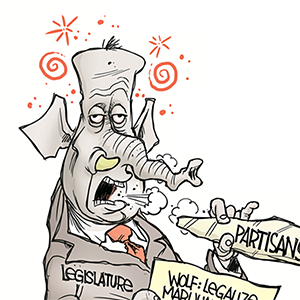Democratic lawmakers reach a California budget agreement. Here are 5 takeaways
Published in News & Features
SACRAMENTO, Calif. — Democratic lawmakers plan to reject billions in proposed cuts to California health care and social services in order to fill a roughly $12 billion deficit. But a spending agreement announced by legislative leaders Monday would still include a freeze on enrollment for undocumented adults to Medi-Cal, the state’s low-income health program.
The shortfall — which lawmakers and Gov. Gavin Newsom blamed on President Donald Trump’s trade policies — presents a challenge for Golden State leaders, who are loath to cut services for California’s poor and undocumented residents but have been dogged by budget deficits for three consecutive years.
Newsom last month proposed the partial Medi-Cal freeze and adding $100 premiums to pay for rising costs. His spending plan also included a nearly 8% cut to state higher education systems and salary freezes for state workers.
State lawmakers must pass a budget bill by June 15. Newsom must sign it by the end of the month.
Speaker Robert Rivas, D-Hollister, and Senate President pro Tempore Mike McGuire, D-Santa Rosa, want to reject some of Newsom’s proposed cuts and delay many others.
“California’s workers and businesses power our nation-leading economy, and our legislative budget prepares the Golden State for deep uncertainty in the face of chaotic and vengeful attacks, and the cuts and tariffs pushed by Republicans and the Trump administration,” McGuire and Rivas said in a joint statement.
“While we have made many tough but necessary decisions to achieve a balanced budget, we will never waver in our commitment to all Californians. This budget fights to protect health care access for millions of the most vulnerable families, speeds-up housing construction, and makes homes more affordable,” they said.
Here are five takeaways from the legislative budget agreement.
Medi-Cal and IHSS
While lawmakers will keep a proposed freeze on enrollment and new premiums for adults with “unsatisfactory immigration status” on Medi-Cal, they want $30 per month premiums, a reduction from the $100 per month Newsom had proposed — and not until July 2027.
The Legislature also wants to reject Newsom’s proposed cuts to In-Home Supportive Services, a program that provides at-home assistance to elderly and disabled residents. The governor had proposed eliminating services for undocumented residents and an overtime cap for in-home care workers.
Both lawmakers and the governor want to end Medi-Cal coverage for weight loss drugs, which could save $85 million in the first year and up to $680 million in 2028.
It’s unclear how the smaller cuts to Medi-Cal and IHSS services would be paid for.
Senators will explore imposing a larger employer contribution for companies whose workers are enrolled in Medi-Cal, according to the Senate Budget Committee’s outline of the spending plan.
“This recognizes that large employers benefit from their employees being enrolled in taxpayer funded health programs instead of employer provided health care programs,” the report reads.
State workers
The Legislature also rejected Newsom’s proposal to withhold salary raises from state employees, which the administration had hoped would save California $767 million.
Newsom offered to negotiate with unions over the payroll pause, though his proposal included language that said the administration could impose reductions without bargaining units’ permission if the Legislature approved that tactic. While the state and public sector unions signed bargaining agreements promising state employees raises in the upcoming fiscal year, those salary increases still require the Legislature to approve that spending.
On Monday, Capitol leaders officially rejected the proposal after some lawmakers and labor groups representing state workers publicly opposed the budget-saving measure in recent weeks.
At least one union, Service Employees International Union Local 1000, planned to meet with the administration at the bargaining table this week to discuss the proposal, though it’s unclear at this point how the Legislature’s rejection will impact negotiations.
Also tucked in the Legislature budget response was a suspension of the proposal to eliminate over 6,000 vacant positions until next year so lawmakers can study the potential impacts of those cuts on the state’s ability to monitor public health and environmental protection. In January, Newsom’s administration said it had saved $1.2 billion from agency budgets by eliminating 6,500 unfilled government jobs.
Higher education, transit and Los Angeles funding
Lawmakers say they’ll reject a 3% cut to University of California and California State University proposed by Newsom. The governor had originally proposed a nearly 8% cut in January.
They also want to provide funds to struggling local governments and transit agencies where Newsom did not. The joint legislative proposal includes a $1 billion loan program for municipalities in Los Angeles County recovering from wildfires and $750 million in loans for Bay Area transit agencies.
It also rejects a proposed $1.1 billion cut to public transit funding proposed by Newsom.
“Public transportation is easy to take for granted, but allowing it to collapse would devastate California’s economic recovery and quality of life,” Bay Area Democratic state Sens. Scott Wiener and Jesse Arreguín said in a joint statement. “This budget agreement extends a critical lifeline that will help transit agencies maintain service while making critical improvements to cleanliness and safety.”
While Newsom did not propose any new funds to help counties enforce voter-approved Proposition 36, lawmakers — after pressure from local governments and law enforcement — included $110 million for Prop 36 in their spending plan.
Some common ground with Newsom
While lawmakers want to reject many of Newsom’s proposed cuts, they’re also on board with some of the governor’s other spending proposals.
They agreed to draw down $7.1 billion from the state’s rainy day fund, which would leave the reserve account with $11.2 billion. However, lawmakers want to pull $2.5 billion from the state’s Special Fund for Economic Uncertainties and leave the account with $2 billion remaining.
As Hollywood struggles to maintain film production and jobs in the state, the Legislature will sign off on a proposed expansion of the Film & Television Tax Credit. While lawmakers did not give a specific number, Newsom has proposed more than doubling the annual tax credit from $300 million to $750 million.
The Legislature is also game with Newsom’s plan to shutter an additional state prison in 2026, though a specific site has not been named by either party. Closing a prison would save roughly $150 million per year. The Legislature found an additional $300 million in unspecified administrative savings, according to Jason Sisney, the Speaker’s budget consultant.
Federal uncertainty ratcheted up
Tensions between California and the federal government reached a new high this week amid protests against immigration raids in Los Angeles and Trump’s takeover of the California National Guard.
The Trump administration is considering canceling broad portions of funding to the state, according to a Friday report by CNN, though the White House did not confirm these reports with The Sacramento Bee. Last week, Transportation Secretary Sean Duffy threatened to pull $4 billion in federal funding for the high-speed rail project
Losing money from the federal government would only exacerbate California’s budget deficit and force lawmakers and Newsom to make more difficult spending decisions.
As of May, about $174 billion in federal funding was projected to flow to the state, but a Congressional spending bill could significantly alter that amount “by cutting health care and social services funding, slashing federal funding for universities and research, and making other damaging changes to federal policy,” Sisney wrote in a blog post.
_____
©2025 The Sacramento Bee. Visit sacbee.com. Distributed by Tribune Content Agency, LLC.







Comments